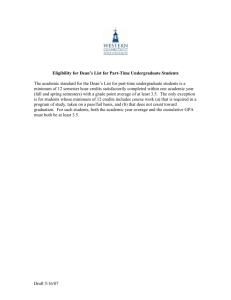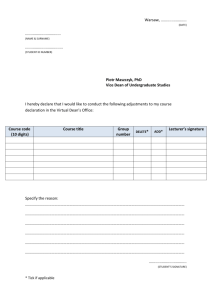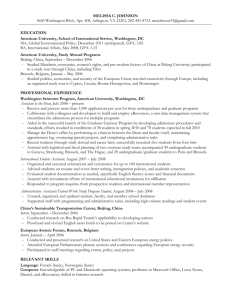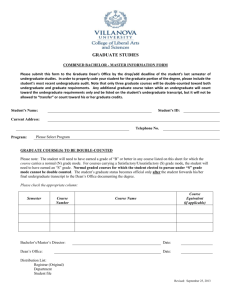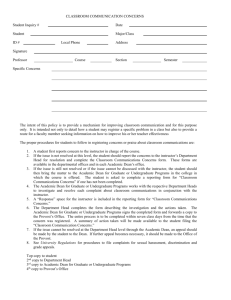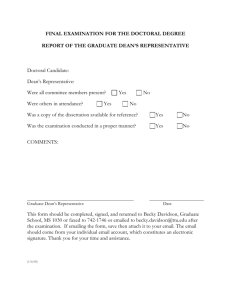VCMAE - Mechanical and Aerospace Engineering
advertisement
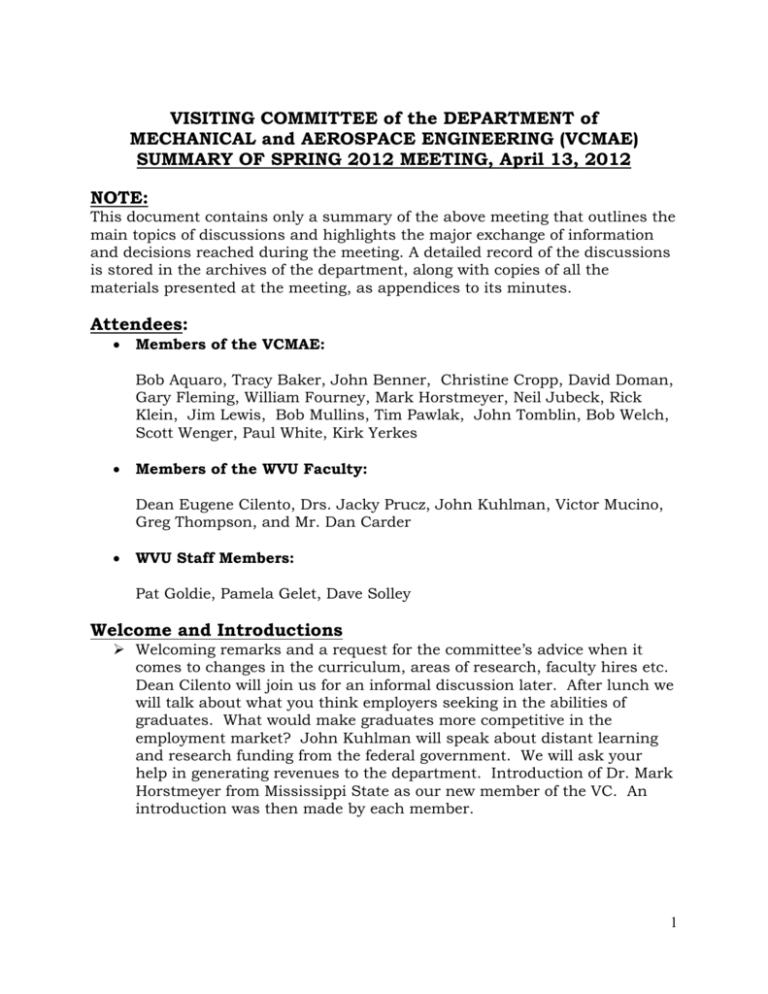
VISITING COMMITTEE of the DEPARTMENT of MECHANICAL and AEROSPACE ENGINEERING (VCMAE) SUMMARY OF SPRING 2012 MEETING, April 13, 2012 NOTE: This document contains only a summary of the above meeting that outlines the main topics of discussions and highlights the major exchange of information and decisions reached during the meeting. A detailed record of the discussions is stored in the archives of the department, along with copies of all the materials presented at the meeting, as appendices to its minutes. Attendees: Members of the VCMAE: Bob Aquaro, Tracy Baker, John Benner, Christine Cropp, David Doman, Gary Fleming, William Fourney, Mark Horstmeyer, Neil Jubeck, Rick Klein, Jim Lewis, Bob Mullins, Tim Pawlak, John Tomblin, Bob Welch, Scott Wenger, Paul White, Kirk Yerkes Members of the WVU Faculty: Dean Eugene Cilento, Drs. Jacky Prucz, John Kuhlman, Victor Mucino, Greg Thompson, and Mr. Dan Carder WVU Staff Members: Pat Goldie, Pamela Gelet, Dave Solley Welcome and Introductions Welcoming remarks and a request for the committee’s advice when it comes to changes in the curriculum, areas of research, faculty hires etc. Dean Cilento will join us for an informal discussion later. After lunch we will talk about what you think employers seeking in the abilities of graduates. What would make graduates more competitive in the employment market? John Kuhlman will speak about distant learning and research funding from the federal government. We will ask your help in generating revenues to the department. Introduction of Dr. Mark Horstmeyer from Mississippi State as our new member of the VC. An introduction was then made by each member. 1 Minutes of the previous meeting were distributed, discussed and voted to be approved. We are in the process of organizing our first MAE Research Day! Groundbreaking for the new building is in September. This year is the 125th anniversary of the college and on June 2nd we will begin celebration and more fund-raising. Our department will move into the new building. Currently it is scheduled to be completed by 2014, but who knows when it comes to construction. You have probably heard about the gift the college received of $34 Million, and if you add the funds from the state it’s actually $45 Million. Some of these funds will go toward the new building, but I am sure the Dean will speak about it. This building will be a major improvement as we are running out of lab space. The Provost was not available to speak to you today it is a Board of Governors Meeting day however we will have someone in the spring meeting from that level to speak to you. We try to renew the charter of this committee every three years. That’s how the college committee and the university operate as well. During the summer we will review; there are some members who are not active. We will come up with new appointments for the fall. This past academic year, probably our most important priority was the faculty searches because it has never happened before to have seven openings for tenure track position. This is very unusual. It is a reflection of our success. We were granted four positions this year and have three from the last year. During the fall semester we screened applicants, developed some criteria for the searches including weighting factor criteria such as abilities to do research, publications, writing proposals and teaching abilities. All of the committees followed a consistent screening process. With information compiled we narrowed down to a short list between three and five candidates per application and those were invited to campus. The offer letter has to be approved by the Dean and the Provost and then it is sent to the applicant. The Dean approved them last week. We can’t say who the new hires are until we receive back the offer letters signed. But we now have three people identified. These positions are all Assistant Professors. Our salaries are higher than the national average for Assistant professors which are very competitive. Full professors however are below the national average. 2 The question was asked what the percentage of state money is coming into the department verses research money. The answer….minuscule, the state money is miniscule. Maybe now close to $3 million dollars from the state but our new research awards were $15 million last year, the level of research expenditures was close to $12 million dollars. This would increase with the hiring of new faculty because the salaries of the new faculty will come from the state but since I’ve been here the amount of state appropriations was always somewhere between $2 and $3 million dollars. Another hurdle that we passed was the assessment reports with the Board of Governors. We had to submit 4 different reports, 2 for the undergrad programs, 1 Aerospace, 1 Mechanical, and then 2 reports for the graduate program, 1 Aerospace, 1 Mechanical. We applied for the program of excellence in education for this program. Rumor is that we got it, but it’s not official yet. The number of our awards keeps growing and we’re getting more and more prestigious. We do have now the best professor in WV in our department, it’s Marcello Napolitano. Next week it will be recognized at the state capital in Charleston, and there is a reception at the president’s house. Larry Banta who is in charge of outreach in our department, he received the Full Bright Scholarship, he’ll go on professional development in the spring semester 2013. Full Bright will support his stay in Italy. We are now listed in the National Academy of Engineering, one of our projects of industry was selected, and Ken Means is advising that. NAE wants to encourage education that is very practical for real life problems. We want to move up in ranking, one way to do it is to be much more proactive than we’ve been in the past, in applying for national awards. Darran Cairns is in charge of coordinating applications for awards, and that is probably one reason we more awards than in the past. This is still confidential, but I can share with you that Ximbo Liu has been selected as Outstanding Researcher of the college, Hailin Li and Ken Means Outstanding Teachers, and Dave is an Outstanding Advisor of the college. Two years ago, Dave got university recognition, the Nick Evans advising award. The dean asked us not to publicize these until the college had the opportunity to make announcements. The students got very prestigious awards; we never had NSF fellows before. News & Strategic Plans in the Statler College (Dean Cilento) Dean Cilento and Associate Dean of Academic Affairs, Warren Myers gave an informal talk. Spoke of trying to get the biomedical engineering undergraduate degree program for certificates going. This will be housed in Chemical engineering. This may be something in the future that another Dean may wish to create a department but that is not where I want to put my resources. I wish to put my resources in the faculty who can deliver a program. The President and the Provost are very supportive of our program. The President has a background in computer science 3 electrical engineering and the Provost in biology. They are very strong supporters of this college and the STEM discipline. We had a shift in the naming of the Statler College. Ben and Jo Statler have been very loyal Ben’s an alumni mining engineering. We have been working for several years for the Statler gift. On December 12th my first granddaughter’s christening and I got a text message from Ben and he said “let’s do it!” That was such great news just before Christmas. With him it was never about the money but he wanted to know it was going to make a difference. His gift of $34 Million privately; he is up to $60 million. With the naming we had it’s a $45 million total gift. It will come in over a few years. There will be $11 million of it has to be paid beginning of 2015, that’s because of the $11 million WV Research Trust Fund, it’s a matching dollar for dollar from state to private gifts. When a donor signs a pledge to pay up by March 2015 they put all that money up front. So we now have an endowment with $11 million in it but it takes about a year to get those resources. Currently it pays between 4 & 5% so over the next few years we will see resources in our college to do some significant things. We will spend it wisely. Ben came out of the Mining Engineering and he wants this to be the best college possible in the country. In order to get Ben to name the college, the university has committee three more senior level positions, $110K to 130K for these positions. They are willing to put that money up to help us recruit three Statler Chairs. I want to recruit at least one Statler Chair this summer that will probably head up energy efficiency. These are five year appointments, renewable upon mutual agreements. We are going to have high expectations of these people. I inherited a college of about 100 faculty and now we are at 129 faculty. That counts department Chairs and the administrators we have 11 new positions that we are recruiting for this fall. That will bring us up to 140. My goal is to get us to 145 or better by 2015. Over the next few years we will continue to invest in new faculty of targeted areas. Please explain the grant writing workshop. The grant writing workshop is new and any faculty can attend. We bring in an external consultant which fits the June schedule best. We do not set up people well for national awards. If we do not get them nominated then you will never get them awarded. We developed a program to help with that. Two years ago in the Wall Street Journal we were recognized as 23rd in the nation for employers who hired our alums and were happy with them. MAE is very highly rated in funding and size of the department. One other thing I would like to mention is the employer ratings on institution on a scale of 1 to 5, with 5 being excellent, we rate about 2.7. We’re trying to do a lot with PR and get our name out there in the industry, a number of 4 industries rate us a 3 or a 3. I’d like to get companies to rate us a 4. The reason we got rated high by the Wall Street Journal is that we run a career fair that has about 150 companies come to campus once a year, just for engineering. Getting the companies here changes their preordained view of what West Virginia is all about. Research Status, Overlook and Initiatives (Dr. Ismail Celik) I have the toughest job of trying to facilitate dollars coming to the department, but of course there is more to do. There is more than dust dollars though. The department is almost half of the college of engineering. I think people by and large know how to write proposals, but it’s tough out there, very competitive. I have started a research highlight posters and brochures for the department. Every few months I am having a faculty member or group of faculty to exhibit their research in a poster and create a brochure. This can be carried and displayed at conferences. The first annual department research fair is now on. We have about 40 posters now exhibiting in NRCCE, 34 undergraduate posters, and 35 graduate research posters. Jury members grade them and then an oral presentation is made and three are selected. We will reward with monetary funds. We will begin having external and internal speakers and ask graduate student to attend. We will have at leave one or two per semester. I have prepared an album of successful proposals with different agencies. This is exhibited on the 3rd floor in the Department. New faculty if they want to know how to write a successful proposal to the Dept. of Energy, NSF or RPE can now take a look at one that has been successfully funded. Dr. Sam Mukdadi has been working in biomedical and has been publicized and used in Health Sciences and will be soon in our department. His expertise is in medical imaging, very sophisticated using ultra sound technology The Dean and the President said this university should be a hub for energy research. Our department is playing a big role in that. We have been successful in our department getting about one-half million dollars of funding. We have very close relationships with many research centers for coal and energy. WVU is leading the clean coal technology. This is a joint research with the Chinese government and the US government. WVU is the leader. This is a $20 million program over five years. 5 Have you identified any barriers to get more money from the private sector? Yes I have. One of them is that we don’t have the infrastructure. We need to invest in infrastructure so that we have something to offer the company. We need to move on this now not in five years. The culture of the university is not there, they don’t like working with industry. It is much more different that academic research and needs a different kind of structure. It is one of my goals that the department goes after private sector funding. We are emphasizing Small Business Research Fund and we want the faculty to connect with the industry. BOG Reports on MAE Graduate Programs (Dr. John Kuhlman) Undergraduate enrollment is up slowly. MS enrollment is down from the previous five years. PhD enrolment is fairly steady. I am giving our productivity of our faculty, but what about quality? I had all data for our annual reports. I looked online until I found about three other program that were ranked near us but above us, that had annual reports that I could obtain. I found UCLA, Boston University and Michigan Tech. With this information you can clearly see here is evidence from another faculty member that we are as productive as many of our peers. So my opinion, if any program at WVU could be called a program of excellence, it’s MAE. Working on these BOG Reports we have discovered a lot of useful information that we didn’t know. Definitely we have to publicize that; include in our annual reports, newsletters etc. WORKING LUNCH Current Plans for Undergraduate Curricula (Dr. Greg Thompson) Our vision is still to try to get a track or an emphasis area for at least the mechanical and most likely the aero as well. An NSF/ASME study says that mechanical engineers of today or in the near future, in the US have to 5 times more employable than mechanical engineers from overseas. The reason is that those engineers can be hired at 1/5 the cost than a US-based ME. So, the first thing I’m going to talk about is some new courses that we’re putting through at the present time. The first is MAE 102 which is to be an equivalent course to the engineering 102. We want to try to attract some of those freshmen in their second semester to get them to start working with us. We’re still going to do the same things that they do in engineering 102 but we’re just going to provide and aerospace/mechanical flavor to that course. Its 3 credit hours. We’ll get calipers in their hands, we’ll use reverse engineering. We have higher prerequisites than the existing 102 has. This is trying to get more design at the freshman year. MAE 271 and 371- this is going to be a 1 credit hour and then 2 credit hours to allow sophomores and juniors to work 6 with our capstone design students. We get a lot of interested undergrads in our projects (Baja, EcoCar) this formally allows them to work with it and get credit hours. It is not a required course and will probably be limited to a handful of students per section per course. The criterion for selection is instructor consent. The sophomore year is for basic CAD work, the junior level you’re managing those basic sophomores and doing higher level engineering. By the time you get into that capstone design course, you have a vision of what needs to be done. The other 29 faculty members prevent me from doing it, because I can’t take them on at the same time, also workload issues. It’s not new but we’ve opened up MAE 497 to allow UG’s to work with faculty and to allow grad students in their labs to get credit for research. This would allow that. There are some faculty members that don’t have money to hire the students as hourly students. This allows you to get those students into your lab. These 3 credits do not count towards graduation. This is an instructor-student 1 on 1, there will be a syllabus created to define what needs to be done. They can do it at 1, 2 or 3 credit hours. These are not required and we are not required to teach them, so if our workload goes up, we do not need to teach them. The main intent was to get more design, more hands on experience to those undergraduates. So everything that we’re doing is to get more design and more teamwork into the curriculum. I didn’t say team building but that is one of the driving factors, but to get these specific management aspects we’re still lacking. A lot of the work that we do is based on student feedback through online surveys. Advising- we have certainly improved on our advising. Dr. Prucz has spent a lot of effort on advising. We have put a lot of resources in advising and we’ve got an excellent advisor. The student responses show we are doing much better. Do you also survey non-engineering classes like math support? Not yet. We are trying to get a handle on our house first. We had some previous discussions with the Math Department. This is from calendar year 2011, individual sections, individual faculty members, but I removed any information to discern who taught the actual course. I’m looking at the grade distributions including withdraw. I want to know if a class has major withdraws going on. Where you have a vast majority as a certain grade distribution, this concerns me. Do you have a mechanic sub-committee? Clearly that’s an issue. No, but we need to look at that. We discussed in a prior curriculum committee meeting about grading guidelines. I think we’re going to lean towards guidelines for faculty, especially as we bring junior faculty in. I 7 think they need a little mentoring on grading. That’s the basic undergraduate summary. I did want to share some laboratory safety. The undergraduate are looking to go to online training or online classes. We’re looking to automate it. One of the things we’ve done since January is developing control charge. We have Kathy Sabolsky as well as Chuck Coleman, and we’ve hired a master in a safety graduate program. They assess the laboratories on a monthly basis. They provide feedback and a pathway to fix the problem. We help the researchers to fix the problems. We provide them solution paths. We’ve received very positive feedback from all involved including environmental health and safety. There was a recent state inspection in which we weren’t fined. Lab safety is much more prevalent and everyone knows it. Abilities and Skills Sought by Employers (VCMAE) From the perspective of someone who sees graduate 3 to 5 years after they’ve come out of college at the test pilot school and they are progressing in their careers. The school is really 3 curriculums; fixed wing, rotary wing and systems. Within that we have 3 types of students; pilots, naval flight officers, and a few engineers that come from test directorates. So we have engineers that represent each of those disciplines. The school came about because in 1945 some people realized that we should get serious about flight testing airplanes. Before that the designer was the test pilot. So at the navy school the engineering discipline we talk about how the test plane works, how the system works. No one really wants to pay for a flight tester. So ½ the day is spent in academics. The other half of the day is flying. They do in the air, take the data and write about it. The third half of the day as we like to say is where they do the report writing and analysis. I’ve been there for 25 years and one of the things that really stick out is that they come with less practical experience. The practical stuff is very important, the Baja Car, Design/Build/fly, that’s critical to somebody having success. I’m very impressed with the effort made at West Virginia to make a very practical school. We get some folks from very highly rated schools and I’m not sure they know which end of the airplane should go first. The other thing we find is communication and writing/reporting. It’s gotten to the point that you get people that cannot put together a logical argument in a cogent fashion on paper. In a lot of cases they can sit down and explain it to you, but I being an engineer hate the English department as much as anybody else, but they can’t construct sentences. The other thing that has somehow been lost overtime is the ability to write and I don’t know why. For the most part the students are very well educated and trained in terms of they understand and are very smart, but the practical application has to go along with that. If you think about it, 8 when a lot of these kids are growing up, they may have never driven a car, so their experience base is pretty limited. Communication/writing skills are poorer than they’ve ever been. Can you comment on the number of technical reports they write in 1 year and they have 2 classes going concurrently? So, you’re graduating a class every 6 months. There are only 4 or 5 major reports, but they end up writing daily reports, so in total about 25 pieces of paper. The last piece we send them is a final check to fly an airplane. Then they have 10 days to come up with a report on all the performance, flying qualities, and systems. It’s an intensive process. I had this conversation with Dr. Long 20 years ago, same conversation. We talked about the lack of hands-on at engineering schools when my son was beginning his education here. One of the things that attracted us was Formula SAE. I knew I sponsored a part of that car in his senior year. The kids that were involved with that project are all having tremendous careers. So I think that Formula SAE was part of that. I was disappointed when WV got out of Formula. I’ve hired engineers that didn’t know a wrench from a screwdriver, a Phillips head, a flat head, etc. So yea there is a lot of that that is missing. I don’t know how you put that into your curriculum. Sometimes it’s lacking. That’s a societal change. I’m 47 years old, and there are people my age, like my brother and sister-n-law that can’t adjust the most basic thing. Fewer people grew up working on engines and farm equipment. Today’s generation- people don’t write anything, they all text and do their own short hand. That’s why 92% of everything we sell in this country has automatic transmission in it. It’s the same reason they can’t shift. What I have noticed is that the computer skills are just awesome. Freshman can usually use their computer skills to reverse engineer things. Understanding from that perspective is also a good way to go. And on top of the physical skills, we have some young ones coming in that can’t even get the new environment. We can’t get some of the young ones to understand that you’ve got to get it right the first time, that you don’t have iterations. A lot of them cannot adjust well. The team we had in ’97, 2 of them had some car experience, they had built hot rods, but the others did not. That was witnessed by the number of stitches and broken fingers. I’m the essay advisor at my school and I am the loudest voice for education and I’ve asked the faculty that it be mandated for one of these teams because of that experience and the totality of that systems view. Let me ask you a question on your involvement with the SAE programs, do you go with the top senior level students? No we recruit freshman. I get up and evangelize and we tried to put simulation in learning because you’re right the freshman kids they know all about computers more than I do, and we try to have calculus/physics. It’s kind of like what you do here, we don’t have 9 credits. It’s just like Friday night I’m buying pizza for everyone to come. Here you are trying to put in credits, so you’re removing the barriers for them and let them be a part of it. I told the kids I was one of these ones “what’s a wrench?” I played basketball, I was going to pay people to do all of this for me, right. Never made it. But if I knew I had a role on that team where I could learn, I would have been on that team. I think some of the younger people come in with the view ‘I’m ready to do something right now and I want to do one thing really well’. It’s like what Tracy was saying ‘no we need someone who can do everything from overseeing a project. We try to make them generalists to a degree and a specialist in the area they were hired. My view for new people coming in is that their education has just become from my standpoint. I think they have an attitude coming that their education is finished and I’m ready to work and our view is different. What I see is they come in and they want to be a manager in 5 years (laughter) and I sit back and I think ‘you know it’s taken me 30 years to understand that big picture’. Tim brought up an interesting point; coming out of college they think they are individual contributor. What we need them to be able to do is recognize who the experts are, and to be able to hook up with the right mentor, and to be able to properly document the problem/proposal, lay it all out, realize who the subject experts are, team with them, synthesize al of that and run a project. Very seldom are they going to come out and be the expert on subject matter in day 1. One communication problem is that you have great ideas but you can’t sell them. Napolitano: I’m sorry to sound contrary on the experimental courses- I see it from both sides. I am a strong believer in programs, but I also see the effects on the academic performance of our students. I have a few weeks left in my classes, and I know 40% of my students can’t come to class because they are going to competitions. I think the departments have to do something with professional society to change the schedule of the competitions. Their grades are going suffer from this. There’s nothing I can do about it. I want to do something for these kids; they are working so hard on these competitions. The last 2 or 3 weeks of the course are pretty much shut down on the other disciplines. They gain a lot of valuable experience, but their academic grades cannot reflect it. The students always have an anxiety, they’ve had all this academic exposure but how are they going to apply these tools when they get a real job? What they don’t always get is that it’s a lifelong learning process. I can confirm our customers are interested in multi-scale for sure. From single part to more components simulation, through multiple physicsmultiple scales simulation they want to see how one component works 10 and fit it into larger simulation to do a lot of stuff on the computer more efficiently. Publications- when I got out of school, it was partially based on who I knew and what I knew, and now a lot of the agencies have gone to computerized systems. It doesn’t matter now if I know this person or not, if the screening criterion doesn’t kick out their name, I can’t even talk to them. I know through the USA jobs system, there’s a spot that says publications. Most of the time that is left blank by students, but if somebody has that, it’s extra points to get their named pulled over someone else. There is a score associated with the name that gets pulled. You can see how somebody ranks through the computer screening criteria. BOG Reports on MAE Undergraduate Programs (Dr. Victor Mucino) I would like to give you a brief report on a major undertaking last fall. I put together a Board of Governors report. We had 4 major reports to be done, 2 for graduate in ME and AE and 2 were for undergraduate, 1 for ME and 1 for AE. Highlights- how does the department relate to the overall strategic plan of the university? There are 5 goals that are part of the strategic plan for WVU. We have to show which way this program related to these goals. No other school in WV offers a continuous bachelor, master and PhD program in ME. The only one that comes close the WV Institute of Technology Montgomery. We have about 600 students all graduate and undergraduate. 450 are undergraduates (without counting the freshmen) plus another 150 graduate students at least. When you look at the amount of money that they pay for tuition… Most of our grad students have a stipend and tuition waiver but tuition paid by undergraduate students plus their living expenses that they bring into the state. When you add the amount of funding that the department receives in research, we are talking about $25 million for Mechanical Engineering. It has been recognized that the production of engineers in the US is not what we need in the future. We are not producing at the rate, the circumstances are requiring. And consequently there is an emphasis to produce more engineers. According to a meeting that took place, there is a need for the 5x engineers, an engineer that is worth 5 times the counterparts from abroad. We have 3 basic objectives1. Proficiency in the field. 2. Being able to respond to the demands of the workforce. 3. Lifelong learning. Also we have ABET outcomes. . We want to see how good these assessments/trends are. Here I have the surveys and the composite ratings of the surveys. We have the same ratings for the objectives. Those assessments were conducted for Mechanical and for the Aerospace program. 11 It’s important to view the assessment of our own work and compare it with our grading. The NSF provided a rating of 22nd in funding for research. We were ranked #23 by the Wall Street Journal and that actually put us on the map. So this is evidence that our program is highly ranked by external entities. That give you an idea of what was included in the Board of Governors report. How are we going to continue to improve learning outcomes? ABET is an on-going activity that is here to stay. This semester we were too busy with the searches to do the 2011 assessment, so we postponed it until fall or spring. We developed a mapping approach to relate surveys, learning outcomes and educational objectives. We have active engagement with Mexico and Italy. Larry Banta is going to Italy as a Fulbright Scholar. So we have and are working many graduate exchange programs. We have to have a better understanding of what our course objectives and learning outcomes are. We need to carefully review the syllabi and make sure of the learning outcomes and the same thing for objectives. MEETING WITH STUDENTS (Already sent out) Cost Benefit Tradeoffs of Distance Learning (Dr. John Kuhlman) A summary of what’s been done so far. Victor Mucino & I met with the distance learning people at the university. I met with the Associate Vice President of Distance Learning. Local in person delivered no thesis masters programs, we had one of those in the 80’s, and it was delivered at Potomac State. I learned some different possibilities about modes for distance education. In this department no one has done anything. This increases the availability of courses, which is a problem we have. We’re at a standstill in our department right now with this. Our Intent with this is to make money. The benefits are to broaden the available coursework. You have to have a niche, and you guys have it with the engine stuff. It helps with reputation. The biggest burden will be in faculty who don’t want to do it, because they have never done it that way before. Status and Business Plans of the CAFEE (Mr. Dan Carder) Our vision is to be a world leader in not only our traditional fuel, engine and emissions, but to extend that into a larger energy portfolio and power systems and try to grow that even larger over flight accommodation and emissions inventories. Our strengths would be that we do a lot in house, we build custom laboratories, we got our start 20 years ago, when the DOE came to us to build the world’s largest vehicle 12 emissions testing laboratory. We delivered on that and have been up and running ever since. Our programs are for industry and they are not related to # of graduate students. We have 3 month contracts; we believe we use multi-faceted approaches. We have software for software engineers in our group. We try to be as interdisciplinary as much as we can beyond engineering. Business model- what our current state was, we’ve been over a 20 year period, a 4 to 5 million dollar enterprise, we peaked around the 2003 time frame when our director Don Lyons, former Chair stepped down and Nigel Clark took over. We have tried to reduce staff according to those dollars. In general I think we became complacent, and focused more on the phone ringing.. For undergraduate we’ve never really targeted in educational needs. We have begun meeting with graduate students twice a month and doing mock interviews, job interviews, and those kinds of activities. This wasn’t available before. We videotape the interviews and send out to HR people we know. They critique them and let students know what they need to do. Future initiatives- increase proposal submissions, a lot of people from industry come to us wanting standardized testing, standardized measurement. We’re trying to extend our research portfolio and to get extra consultants out there to represent our organization. We need to be more pursuant with federal programs, developing with the managers. We would like to develop some type of review panel that looks at CAFEE that meets at least bi-annually this would give us some direction on where our operations are lacking. We will put together a business plan from the dean in the next month or so. Probably we’ll have to go with reductions in staff to bring the alignment with current revenues. Much of our earlier funding through congressional funding. CAFEE can operate as a business entity and be self-sufficient. VCMAC Business, Wrap Up, Action Items (Dr. Jacky Prucz) The next meeting will probably be October 12th. Let me know any additional thoughts you may have. We will try to develop 2 documents; 1 is the summary from the graduate students, and the other is a draft letter for the committee about the changes in our undergraduate program. Hopefully the searches will wrap up soon and I’ll get the minutes out to you sooner. One last comment about CAFEE- at least 2 of the new positions, the faculty will provide much needed support for CAFEE. I’m very optimistic. They lost faculty and are not active not in writing proposals. They got complacent because the money was coming too easily but it’s not anymore. We are all aware you don’t get funding unless you write proposals. Thank you very much for coming! 13

